Ultra-Broadband Wearable Antenna with Thermal Sensitivity Based on Surface-Modified TiO2-PTFE-PDMS Nanocomposites
Abstract
1. Introduction
2. Materials and Methods
2.1. Preparation of Substrate
2.1.1. Modification of Nano-TiO2 Powder
2.1.2. Preparation of Composite Dielectric Substrate
2.2. Performance Testing
2.2.1. Infrared Spectral Testing
2.2.2. Dielectric Property Testing
2.2.3. SEM Characterization
2.3. Antenna Structure Design
2.3.1. Surface Current Distribution
2.3.2. Radiation Efficiency and Peak Gain
2.3.3. Fabrication of Antenna
3. Results and Applications
3.1. Antenna Frequency Test
3.2. Radiation Performance Test of Antenna
3.3. Heating Performance of Antenna
3.4. Antenna Performance on Body Models
3.5. Comparison
4. Conclusions
Author Contributions
Funding
Data Availability Statement
Conflicts of Interest
References
- Mohamadzade, B.; Hashmi, R.M.; Simorangkir, R.B.V.B.; Gharaei, R.; Ur Rehman, S.; Abbasi, Q.H. Recent Advances in Fabrication Methods for Flexible Antennas in Wearable Devices: State of the Art. Sensors 2019, 19, 2312. [Google Scholar] [CrossRef] [PubMed]
- Hertleer, C.; Tronquo, A.; Rogier, H.; Vallozzi, L.; Van Langenhove, L. Aperture-Coupled Patch Antenna for Integration Into Wearable Textile Systems. IEEE Antennas Wirel. Propag. Lett. 2007, 6, 392–395. [Google Scholar] [CrossRef]
- Khaleel, H.R.; Al-Rizzo, H.M.; Rucker, D.G. Compact Polyimide-Based Antennas for Flexible Displays. J. Disp. Technol. 2012, 8, 91–97. [Google Scholar] [CrossRef]
- Caldeira, J.M.; Rodrigues, J.J.; Lorenz, P. Toward ubiquitous mobility solutions for body sensor networks on healthcare. IEEE Commun. Mag. 2012, 50, 108–115. [Google Scholar] [CrossRef]
- Gao, G.-P.; Hu, B.; Wang, S.F.; Yang, C. Wearable Circular Ring Slot Antenna With EBG Structure for Wireless Body Area Network. IEEE Antennas Wirel. Propag. Lett. 2018, 17, 434–437. [Google Scholar] [CrossRef]
- Stoppa, M.; Chiolerio, A. Wearable Electronics and Smart Textiles: A Critical Review. Sensors 2014, 14, 11957–11992. [Google Scholar] [CrossRef]
- Paracha, K.N.; Rahim, S.K.A.; Soh, P.J.; Kamarudin, M.R.; Tan, K.-G.; Lo, Y.C.; Islam, M.T. A Low Profile, Dual-band, Dual Polarized Antenna for Indoor/Outdoor Wearable Application. IEEE Access 2019, 7, 33277–33288. [Google Scholar] [CrossRef]
- Zhang, K.; Soh, P.J.; Yan, S. Meta-Wearable Antennas—A Review of Metamaterial Based Antennas in Wireless Body Area Networks. Materials 2021, 14, 149. [Google Scholar] [CrossRef]
- Xu, F.; Wei, B.; Li, W.; Liu, J.; Liu, W.; Qiu, Y. Cylindrical conformal single-patch microstrip antennas based on three-dimensional woven glass fiber/epoxy resin composites. Compos. B 2015, 78, 331–337. [Google Scholar] [CrossRef]
- Al-Sehemi, A.G.; Al-Ghamdi, A.A.; Dishovsky, N.T.; Malinova, P.; Atanasov, N.T.; Atanasova, G.L. Natural rubber composites containing low and high dielectric constant fillers and their application as substrates for compact flexible antennas. Polym. Polym. Compos. 2021, 29, 233–245. [Google Scholar] [CrossRef]
- Babar, A.A.; Bhagavati, V.A.; Ukkonen, L.; Elsherbeni, A.Z.; Kallio, P.; Sydanheimo, L. Performance of high-permittivity ceramic-polymer composite as a substrate for UHF RFID tag antennas. Int. J. Antennas Propag. 2012, 3, 905409. [Google Scholar] [CrossRef]
- Vilesh, V.L.; Ganesanpotti, S. Silicone Rubber-BaBiLiTeO6 Composites: Flexible Microwave Substrates for 5G Applications. J. Electron. Mater. 2022, 51, 3237–3247. [Google Scholar] [CrossRef]
- Catarinucci, L.; Chietera, F.P.; Colella, R. Permittivity-Customizable Ceramic-Doped Silicone Substrates Shaped With 3-D-Printed Molds to Design Flexible and Conformal Antennas. IEEE Trans. Antennas Propag. 2022, 68, 4967–4972. [Google Scholar] [CrossRef]
- Elmobarak, H.A.; Rahim, S.K.A.; Castel, X.; Himdi, M. Flexible conductive fabric/E-glass fibre composite ultra-wideband antenna for future wireless networks. IET Microw. Antennas Propag. 2019, 13, 455–459. [Google Scholar] [CrossRef]
- Loss, C.; Gonçalves, R.; Pinho, P.; Salvado, R. Influence of some structural parameters on the dielectric behavior of materials for textile antennas. Text. Res. J. 2019, 89, 1131–1143. [Google Scholar] [CrossRef]
- Salvado, R.; Loss, C.; Gonçalves, R.; Pinho, P. Textile Materials for the Design of Wearable Antennas: A Survey. Sensors 2012, 12, 15841–15857. [Google Scholar] [CrossRef]
- Lilja, J.; Salonen, P.; Kaija, T.; De, M. Design and Manufacturing of Robust Textile Antennas for Harsh Environments. IEEE Trans. Antennas Propag. 2012, 60, 4130–4140. [Google Scholar] [CrossRef]
- Wang, Y.; Edwards, E.; Hooper, I.; Clow, N.; Grant, P.S. Scalable polymer-based ferrite composites with matching permeability and permittivity for high-frequency applications. Appl. Phys. A 2015, 120, 609–614. [Google Scholar] [CrossRef]
- Koulouridis, S.; Kiziltas, G.; Zhou, Y.; Hansford, D.J.; Volakis, J.L. Polymer–Ceramic Composites for Microwave Applications: Fabrication and Performance Assessment. IEEE Trans. Microw. Theory Tech. 2006, 54, 4202–4208. [Google Scholar] [CrossRef]
- Liu, Y.; Wu, P.; Kang, P.; Li, L.; Li, Q. PDMS-based composites with stable dielectric properties at varied frequency via Sr-doped CaCu3Ti4O12 nanowires for flexible wideband antenna substrate. J. Mater. Sci. Mater. Electron. 2021, 32, 430–441. [Google Scholar] [CrossRef]
- Dang, Z.M.; Yuan, J.K.; Zha, J.W.; Zhou, T.; Li, S.T.; Hu, G.H. Fundamentals, processes and applications of high-permittivity polymer-matrix composites. Prog. Mater. Sci. 2011, 57, 660–723. [Google Scholar] [CrossRef]
- Ivanova, R.; Kotsilkova, R.; Ivanov, E.; Donato, R.K.; Silvestre, C. Composition dependence in surface properties of poly(lactic acid)/graphene/carbon nanotube composites. Mater. Chem. Phys. 2020, 249, 122702. [Google Scholar] [CrossRef]
- Zhang, Y.; Huo, P.; Wang, J.; Liu, X.; Rong, C.; Wang, G. Dielectric percolative composites with high dielectric constant and low dielectric loss based on sulfonated poly(aryl ether ketone) and a-MWCNTs coated with polyaniline. J. Mater. Chem. C 2013, 1, 4035–4041. [Google Scholar] [CrossRef]
- Feng, M.; Huang, Y.; Cheng, T.; Liu, X. Synergistic effect of graphene oxide and carbon nanotubes on sulfonated poly(arylene ether nitrile)-based proton conducting membranes. Int. J. Hydrogen Energy 2017, 42, 8224–8232. [Google Scholar] [CrossRef]
- Ali, N.; Ali, F.; Saeed, S. Structural characteristics and electrochemical properties of sulfonated polyimide claybased composite fabricated by a solution casting method. J. Mater. Sci. Mater. Electron. 2019, 30, 19164–19172. [Google Scholar] [CrossRef]
- Nguyen, T.C.; Nguyen, T.D.; Vu, D.T.; Dinh, D.-P.; Nguyen, A.-H.; Ly, T.-N.; Dao, P.-H.; Bach, L.-G.; Thai, H. Modification of titanium dioxide nanoparticles with 3-(trimethoxysilyl)propyl methacrylate silane coupling agent. J. Chem. 2020, 2020, 1381407. [Google Scholar] [CrossRef]
- Vasudevan, S.; Fullerton-Shirey, S.K. Effect of nanoparticle shape on the electrical and thermal properties of solid polymer electrolytes. J. Phys. Chem. C 2019, 123, 10720–10726. [Google Scholar] [CrossRef]
- Thomason, J. A review of the analysis and characterisation of polymeric glass fibre sizings. Polym. Test. 2020, 85, 106421. [Google Scholar] [CrossRef]
- Zindani, D.; Kumar, K. An Insight into Additive Manufacturing of Fiber Reinforced Polymer Composite. Int. J. Lightweight Mater. Manuf. 2019, 2, 267–278. [Google Scholar] [CrossRef]
- Wang, C.; Mao, H.; Wang, C.; Fu, S. Dispersibility and Hydrophobicity Analysis of Titanium Dioxide Nanoparticles Grafted with Silane Coupling Agent. Ind. Eng. Chem. Res. 2011, 50, 11930–11934. [Google Scholar] [CrossRef]
- Cheng, Q.; Li, C.; Pavlinek, V.; Saha, P.; Wang, H. Surface-modified antibacterial TiO2/Ag+ nanoparticles: Preparation and properties. Appl. Surf. Sci. 2006, 252, 4154–4160. [Google Scholar] [CrossRef]
- Sharma, P.K.; Chung, J.Y. Evaluation of polydimethylsiloxane (PDMS) as a substrate for the realization of flexible/wearable antennas and sensors. Micromachines 2023, 14, 735. [Google Scholar] [CrossRef] [PubMed]
- Kundu, S.; Chatterjee, A.; Jana, S.K.; Parui, S.K. A Compact Umbrella-Shaped UWB Antenna with Gain Augmentation Using Frequency Selective Surface. Radioengineering 2018, 27, 448–454. [Google Scholar] [CrossRef]
- Zhang, J.; Cao, P.; Huang, Y.; Alrawashdeh, R.; Zhu, X. Compact planar ultra-wideband antenna with quintuple band-notched characteristics. Microw. Antennas Propag. Lett. 2014, 9, 206–216. [Google Scholar] [CrossRef]
- Hertleer, C.; Rogier, H.; Vallozzi, L.; Van Langenhove, L. A textile antenna for off-body communication integrated into protective clothing for firefighters. IEEE Trans. Antennas Propag. 2009, 57, 919–925. [Google Scholar] [CrossRef]
- Hassan, A.; Ali, S.; Hassan, G.; Bae, J.; Lee, C.H. Inkjet-printed antenna on thin PET substrate for dual band Wi-Fi communications. Microsyst. Technol. 2017, 23, 3701–3709. [Google Scholar] [CrossRef]
- James, N.K.; Jacob, K.S.; Bae, J.; Lee, C.H. Ba(Mg1/3Ta2/3)O3 filled ptfe composites for microwave substrate applications. Mater. Chem. Phys. 2010, 122, 507–511. [Google Scholar] [CrossRef]
- Saha, T.K.; Knaus, T.N.; Khosla, A.; Bae, J.; Lee, C.H. A CPW-fed flexible UWB antenna for IoT applications. Microsyst. Technol. 2022, 28, 5–11. [Google Scholar] [CrossRef]
- Chaouche, Y.B.; Nedil, M.; Messaoudene, I.; Bae, J.; Lee, C.H. CPW-fed Hexagonal Modified Sierpinski Carpet Fractal Antenna for UWB Applications. In Proceedings of the IEEE International Symposium on Antennas and Propagation and USNC-URSI Radio Science Meeting, Boston, MA, USA, 8–13 July 2018. [Google Scholar]
- Saha, T.K.; Goodbody, C.; Karacolak, T.; Sekhar, P.K. A compact monopole antenna for ultra-wideband applications. Microw. Opt. Technol. Lett. 2019, 61, 182–186. [Google Scholar] [CrossRef]
- Abirami, B.S.; Sundarsingh, E.F. EBG-Backed Flexible Printed Yagi-Uda Antenna for On-Body Communication. IEEE Trans. Antennas Propag. 2017, 65, 3762–3765. [Google Scholar] [CrossRef]
- Li, J. Computer Aided Modeling and Simulation of Cooling Fan System. In Proceedings of the 2011 International Symposium on Information Engineering and Electronic Commerce (IEEC2011), San José, CA, USA, 5–9 June 2011. [Google Scholar]
- Li, E.; Li, X.J.; Seet, B.-C. A Triband Slot Patch Antenna for Conformal and Wearable Applications. Electronics 2021, 10, 3155. [Google Scholar] [CrossRef]
- Zhang, R.; Liu, J.W.; Wang, Y.Y.; Luo, Z.; Zhang, B.; Duan, J. Flexible Wearable Composite Antennas for Global Wireless Communication Systems. Sensors 2021, 21, 6083. [Google Scholar] [CrossRef] [PubMed]
- Jabbar, A.; Zubair, M.; Naveed, M.A.; Mehmood, M.Q.; Massoud, Y. A photopaper-based low-cost, wideband wearable antenna for wireless body area network applications. IET Microw. Antennas Propag. 2022, 16, 962–970. [Google Scholar] [CrossRef]
- Simorangkir, R.B.V.B.; Kiourti, A.; Esselle, K.P. UWB Wearable Antenna With a Full Ground Plane Based on PDMS-Embedded Conductive Fabric. IEEE Antennas Wirel. Propag. Lett. 2018, 17, 493–496. [Google Scholar] [CrossRef]
- Zhang, C.Y.; Guo, J.Q.; Lian, S.L.; Chi, Z.T.; Sun, Z.; Zheng, Y.; Sun, B.; Liu, T. A flexible and transparent pliers shaped antenna for ultra-wideband applications. Flex. Print. Electron. 2023, 8, 035010. [Google Scholar] [CrossRef]
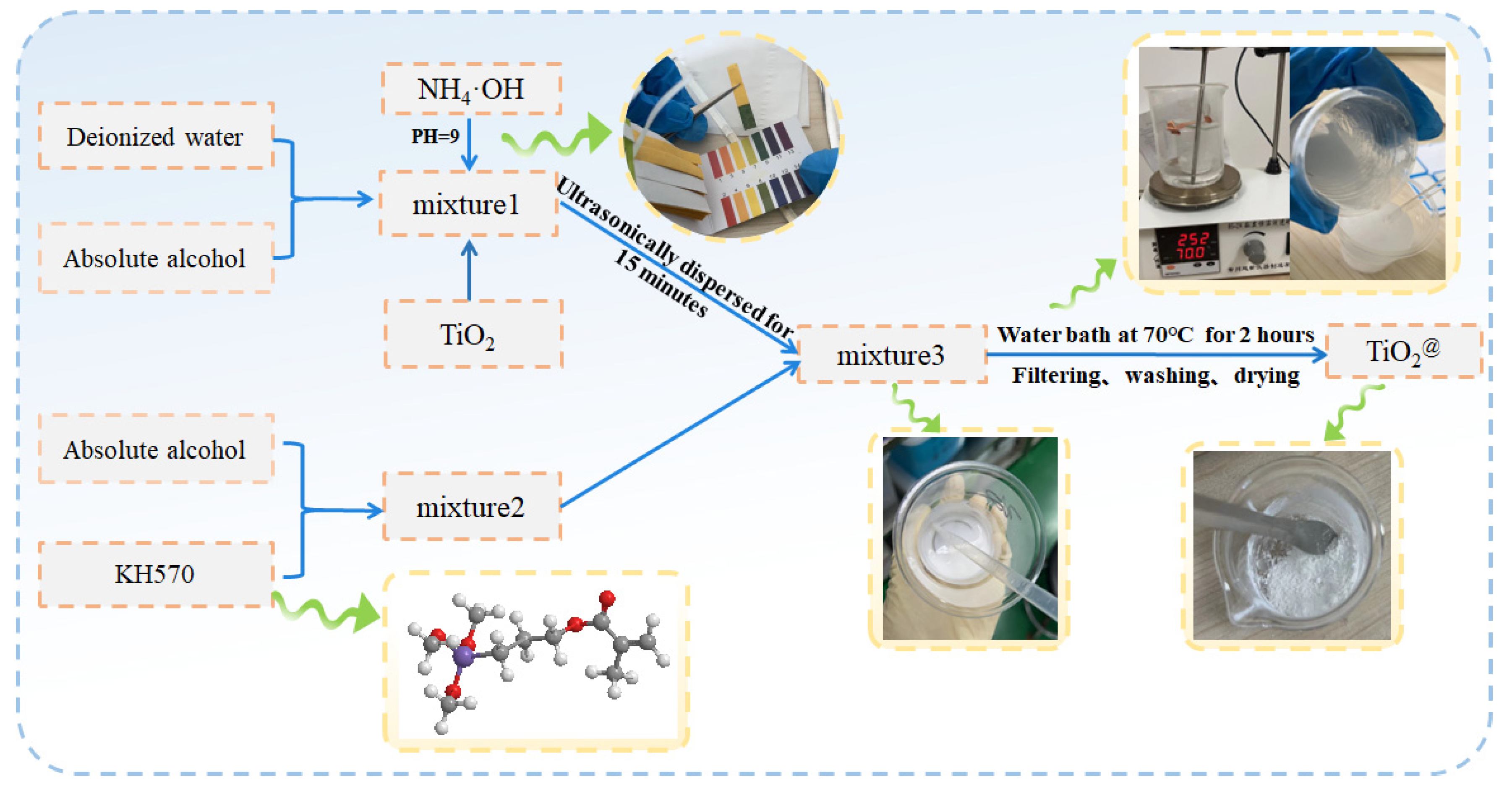
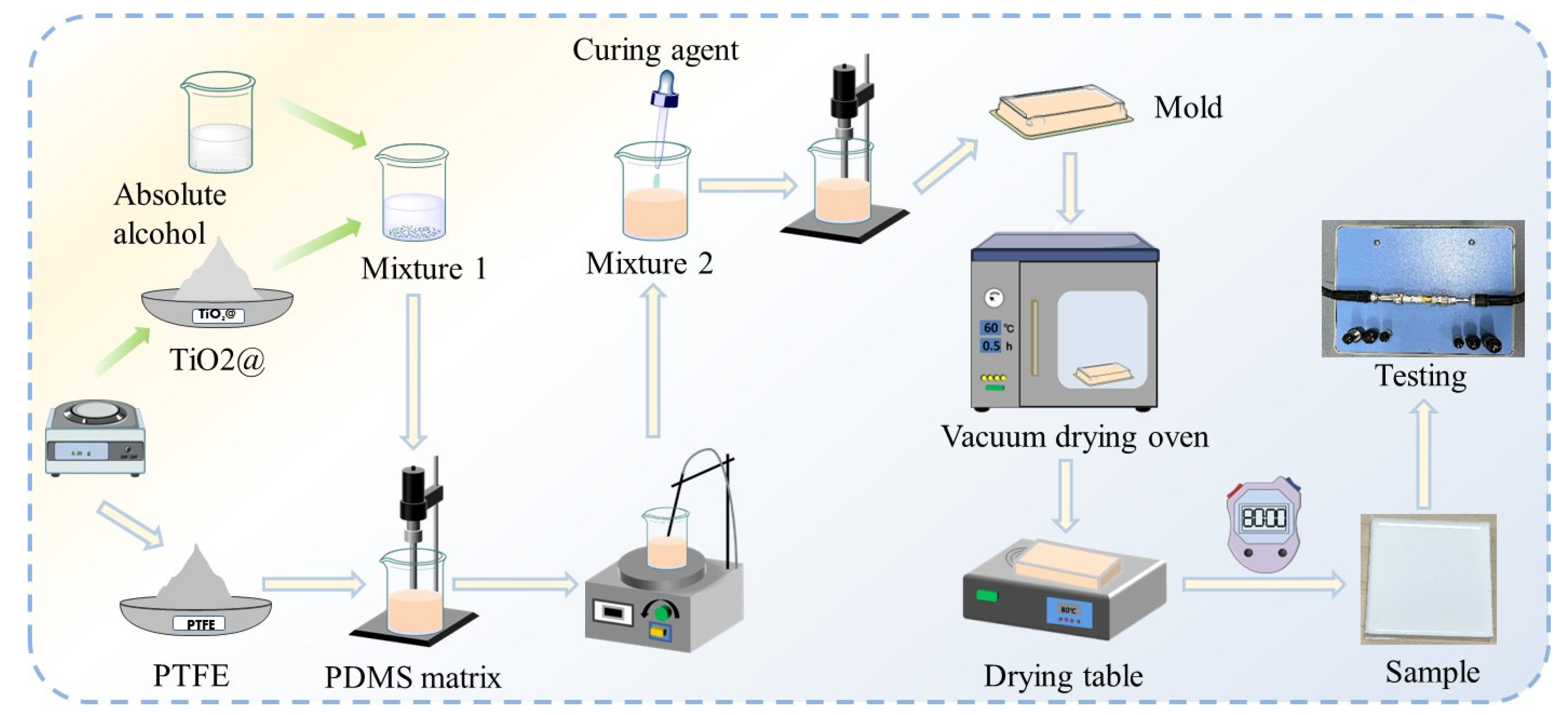
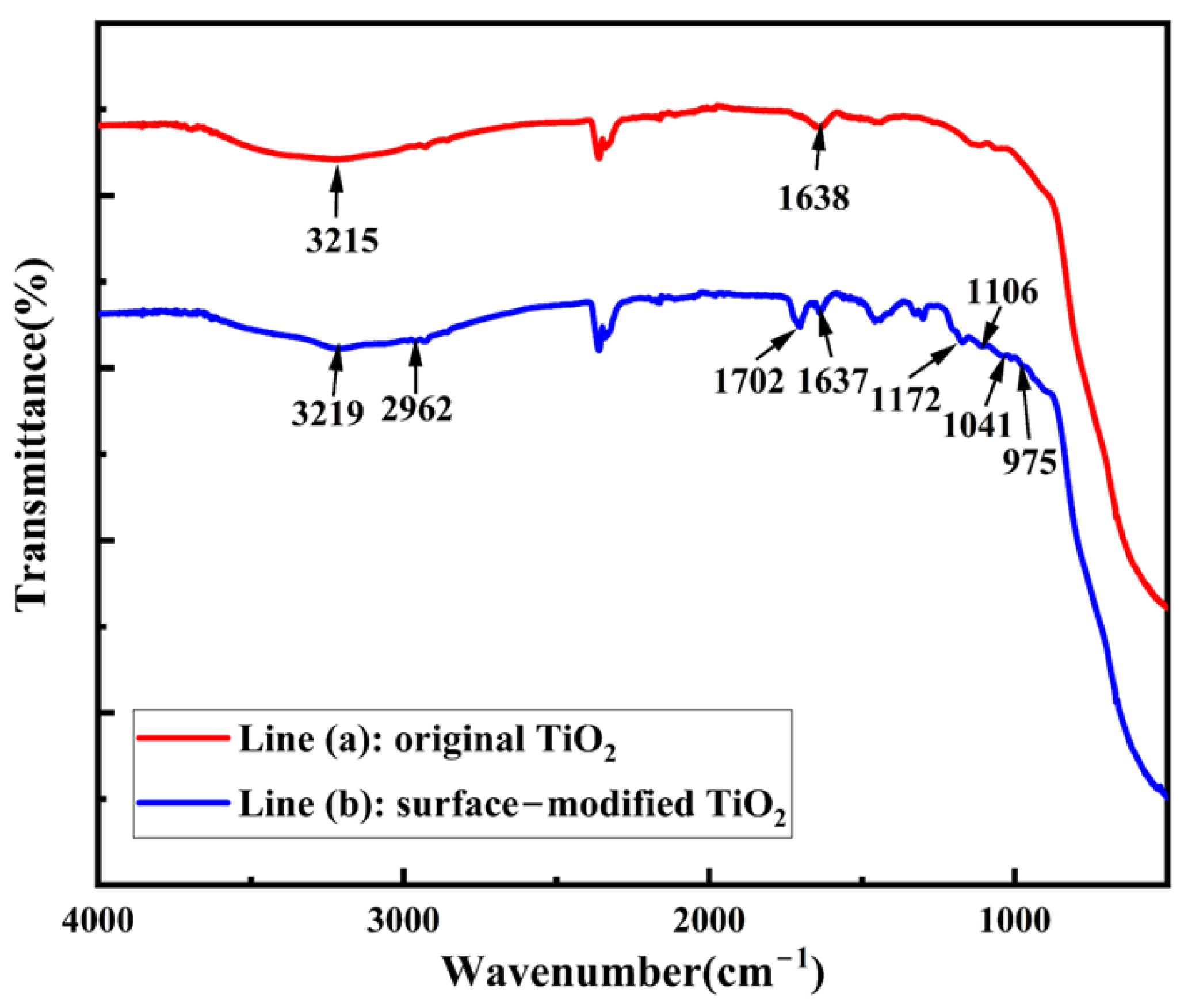


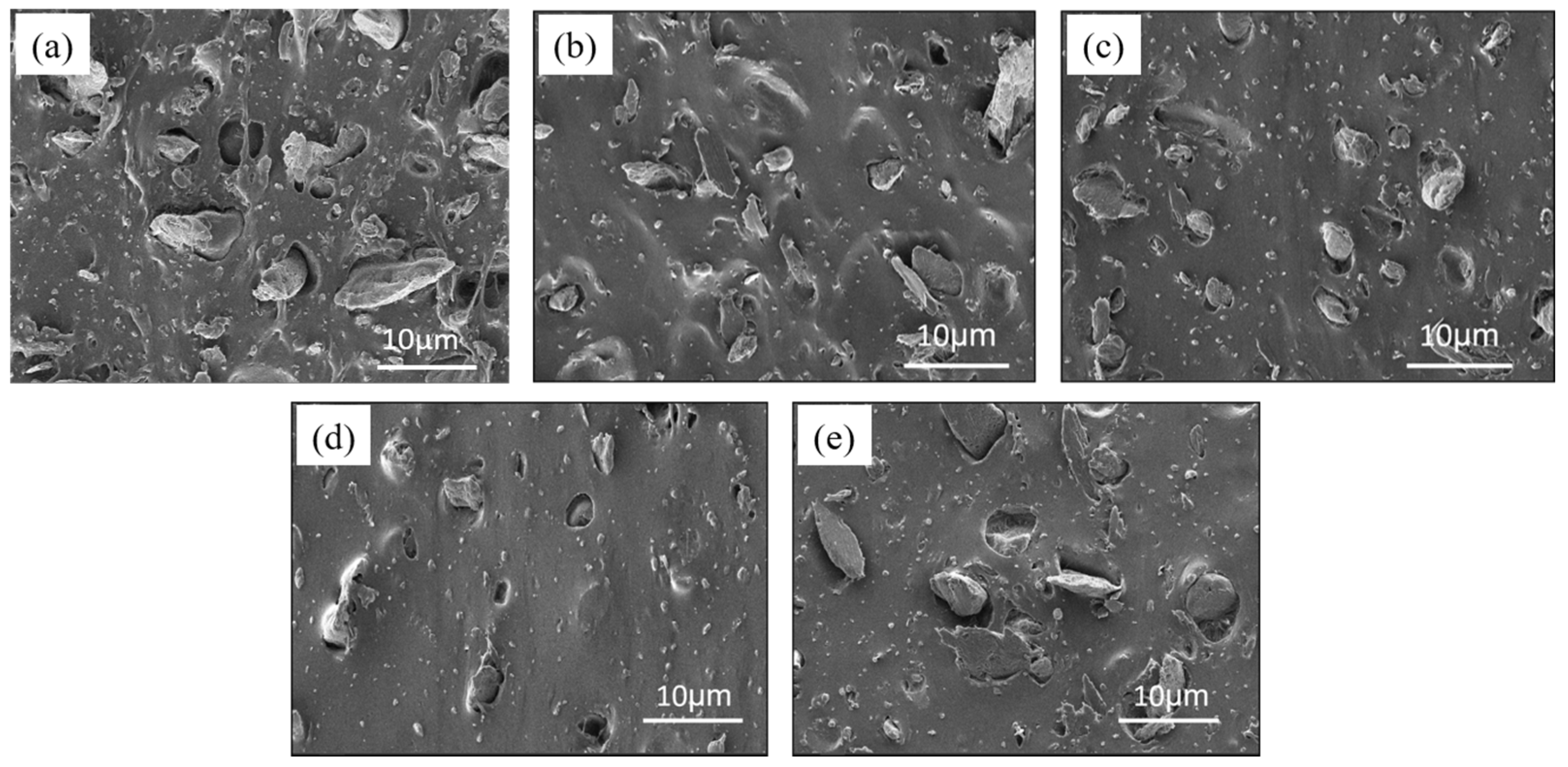
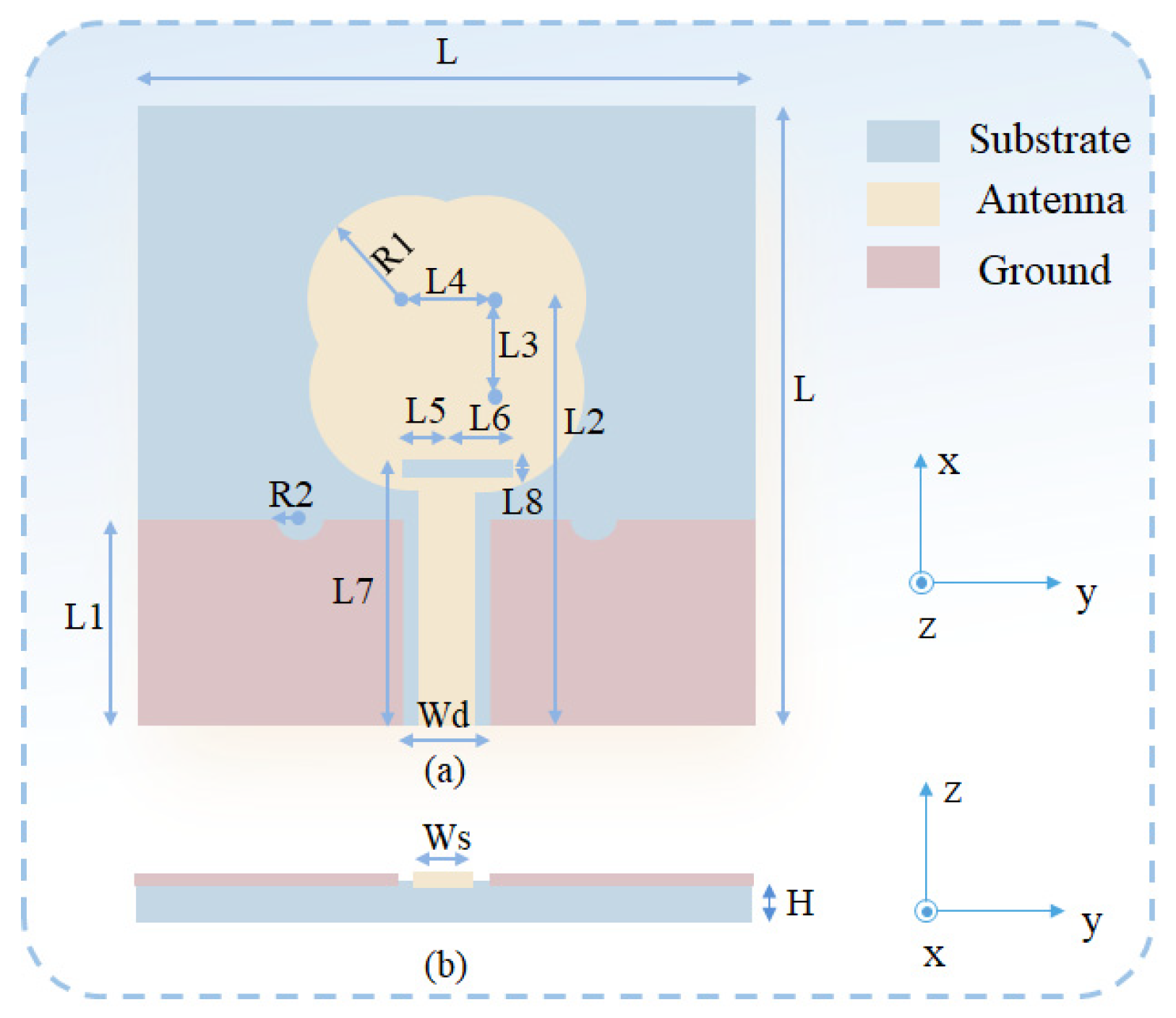
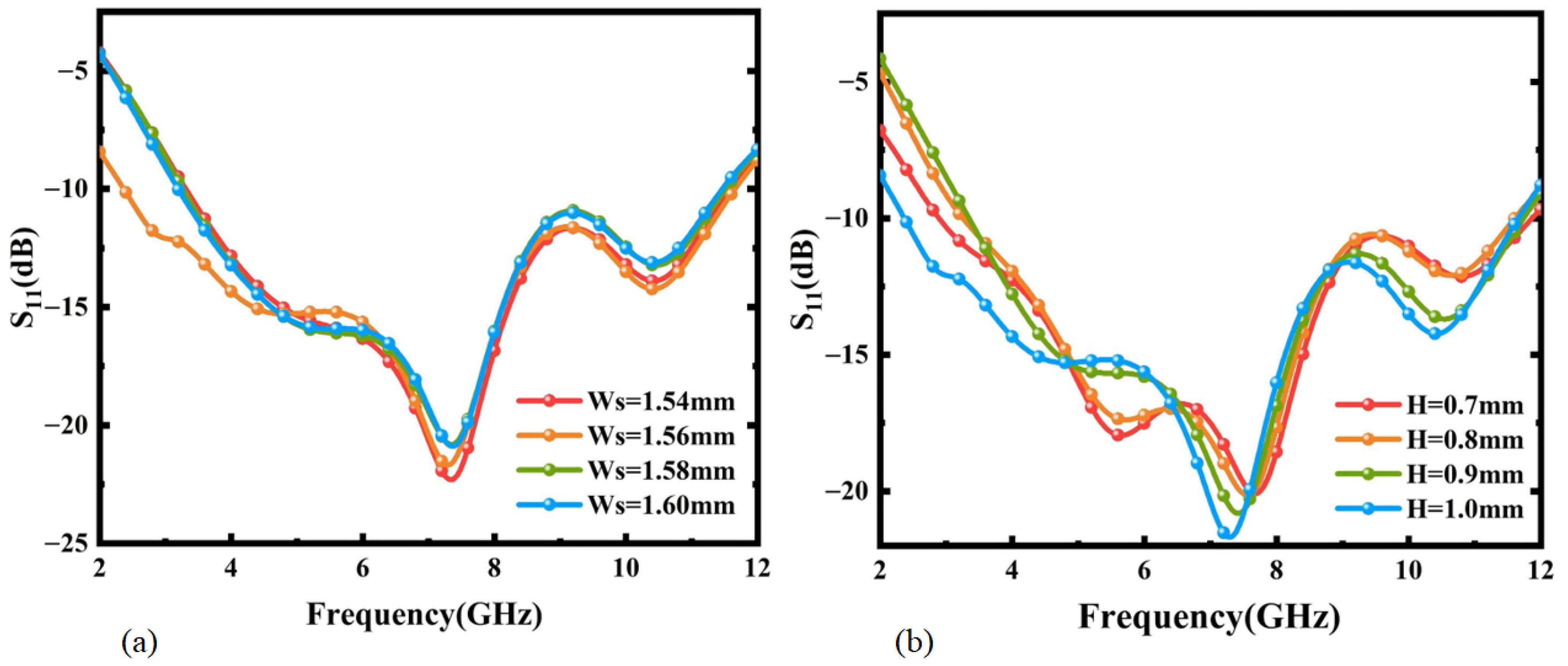
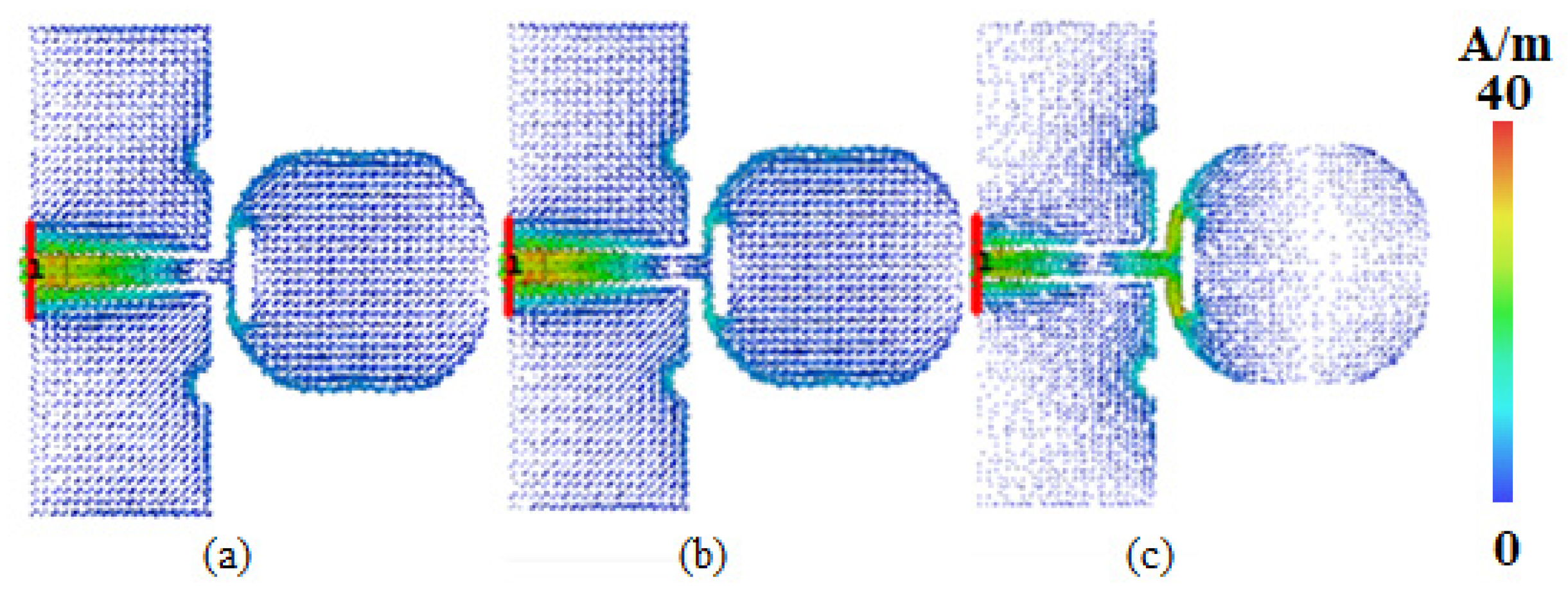

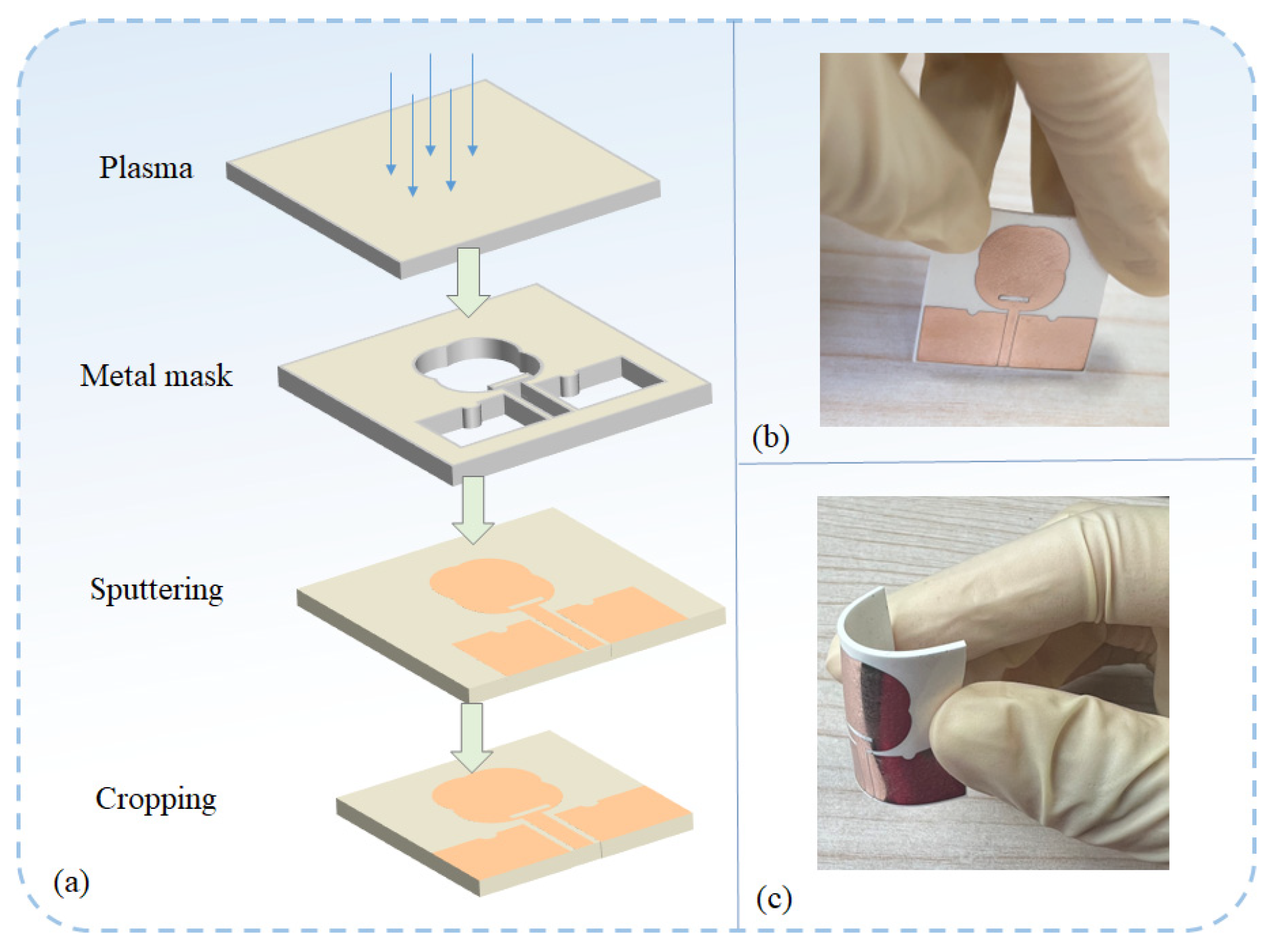
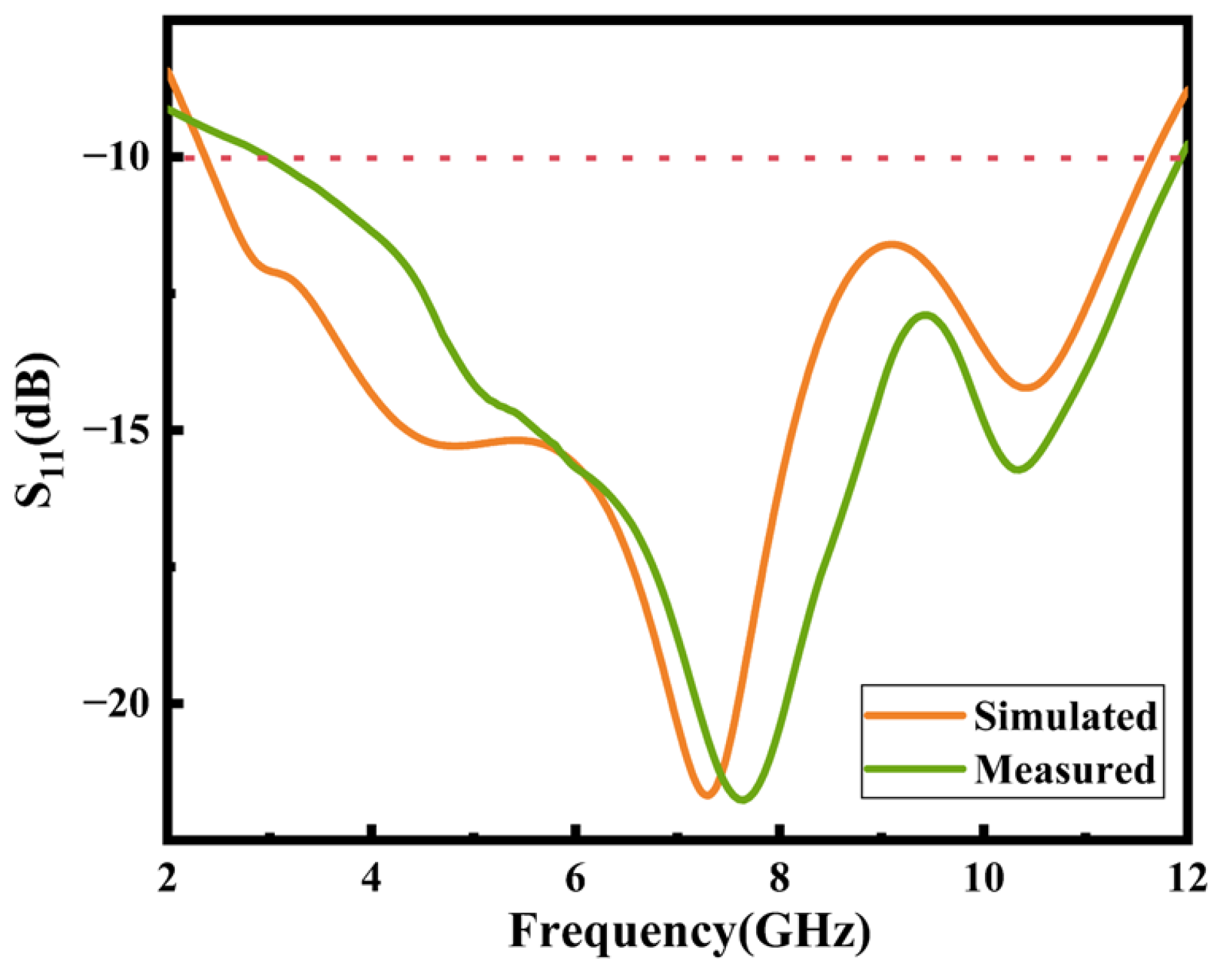
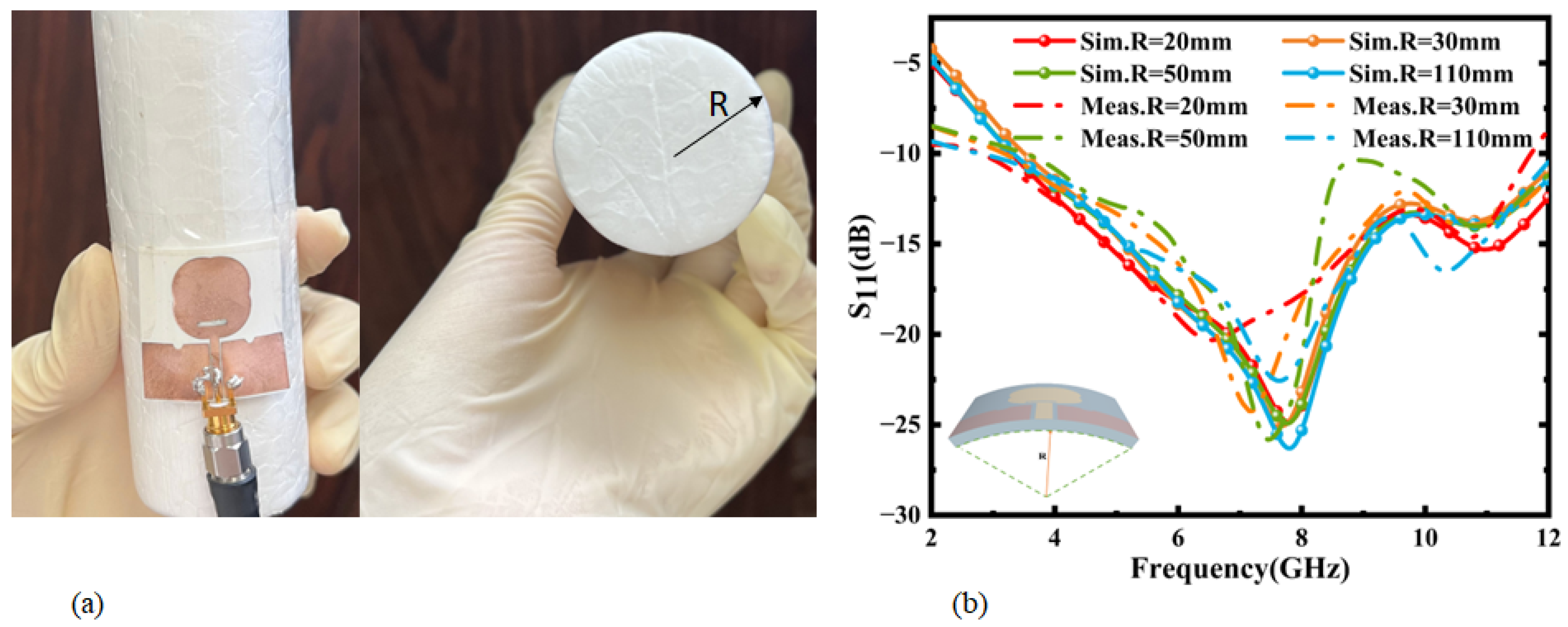




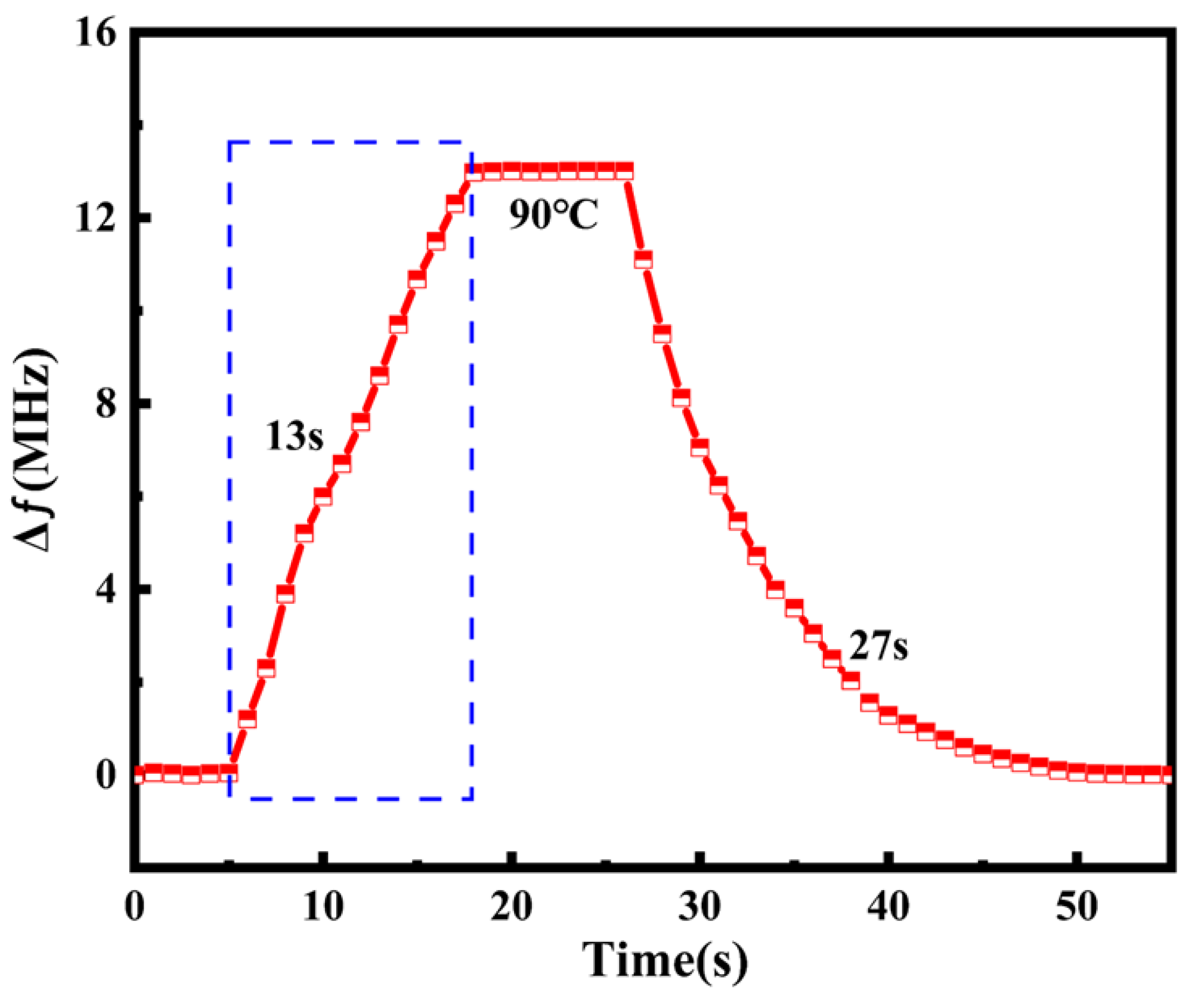

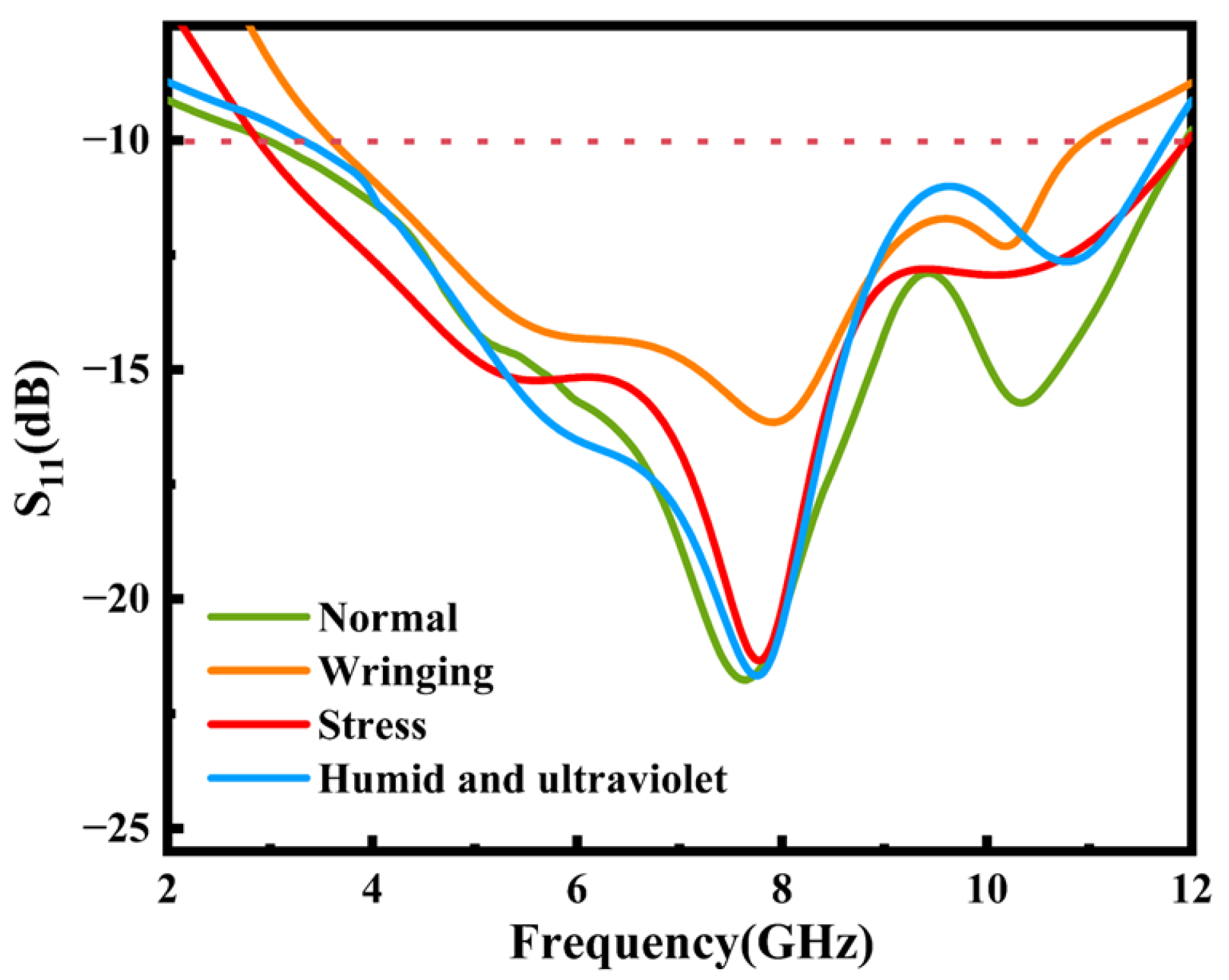
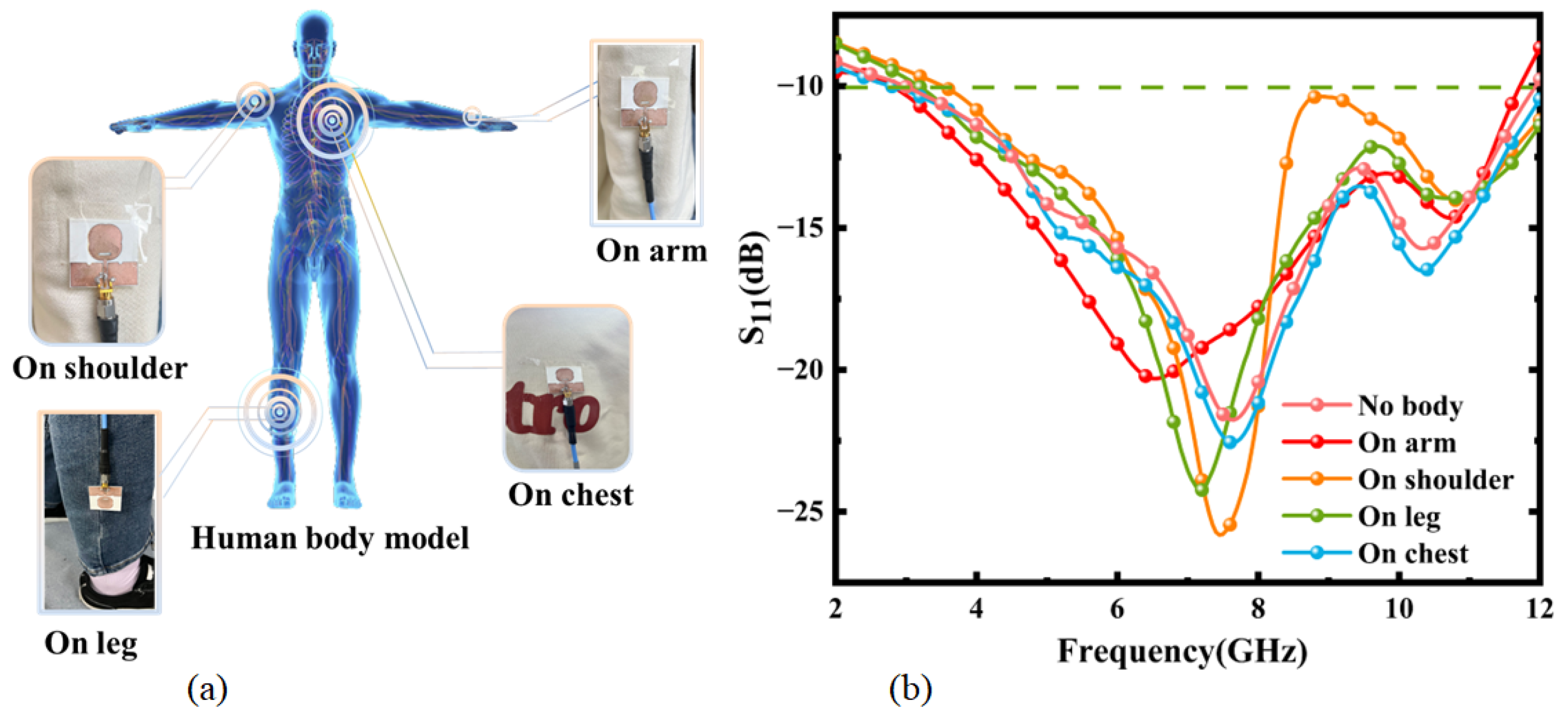





| Parameter | Value (mm) | Parameter | Value (mm) |
|---|---|---|---|
| L | 30 | L7 | 13.5 |
| L1 | 11 | L8 | 1 |
| L2 | 22 | R1 | 6 |
| L3 | 4 | R2 | 1 |
| L4 | 3 | H | 1 |
| L5 | 2.9 | Wd | 2.3 |
| L6 | 3.1 | Ws | 1.56 |
| Ref. | Dimensions (mm) | Bandwidth (GHz) | Substrate Used | Radiation Efficiency (%) | Gain (dB) |
|---|---|---|---|---|---|
| [13] | 170 × 170 | 2.35–2.45 | alumina and barium titanate | - | data |
| [14] | 40.5 × 40 | 3.3–12 | E-glass fiber mat and epoxy resin | 94 | - |
| [45] | 40 × 30 | 2.3–5.3 | photo paper | 80.29 | - |
| [46] | 80 × 67 | 3.7–10.3 | PDMS | 45 | 5 |
| [47] | 29 × 25 | 1.73–20 | PDMS | 40 | 4.12 |
| Proposed | 30 × 30 | 2.37–10.66 | TiO2-PTFE-PDMS | 95.4 | 3.34 |
Disclaimer/Publisher’s Note: The statements, opinions and data contained in all publications are solely those of the individual author(s) and contributor(s) and not of MDPI and/or the editor(s). MDPI and/or the editor(s) disclaim responsibility for any injury to people or property resulting from any ideas, methods, instructions or products referred to in the content. |
© 2025 by the authors. Licensee MDPI, Basel, Switzerland. This article is an open access article distributed under the terms and conditions of the Creative Commons Attribution (CC BY) license (https://creativecommons.org/licenses/by/4.0/).
Share and Cite
Mi, B.; Meng, Q.; Duan, J.; Su, B.; Jian, M.; Shi, Y.; Zhang, B. Ultra-Broadband Wearable Antenna with Thermal Sensitivity Based on Surface-Modified TiO2-PTFE-PDMS Nanocomposites. Micromachines 2025, 16, 629. https://doi.org/10.3390/mi16060629
Mi B, Meng Q, Duan J, Su B, Jian M, Shi Y, Zhang B. Ultra-Broadband Wearable Antenna with Thermal Sensitivity Based on Surface-Modified TiO2-PTFE-PDMS Nanocomposites. Micromachines. 2025; 16(6):629. https://doi.org/10.3390/mi16060629
Chicago/Turabian StyleMi, Baoli, Qingya Meng, Junping Duan, Bowen Su, Ma Jian, Yangyi Shi, and Binzhen Zhang. 2025. "Ultra-Broadband Wearable Antenna with Thermal Sensitivity Based on Surface-Modified TiO2-PTFE-PDMS Nanocomposites" Micromachines 16, no. 6: 629. https://doi.org/10.3390/mi16060629
APA StyleMi, B., Meng, Q., Duan, J., Su, B., Jian, M., Shi, Y., & Zhang, B. (2025). Ultra-Broadband Wearable Antenna with Thermal Sensitivity Based on Surface-Modified TiO2-PTFE-PDMS Nanocomposites. Micromachines, 16(6), 629. https://doi.org/10.3390/mi16060629






